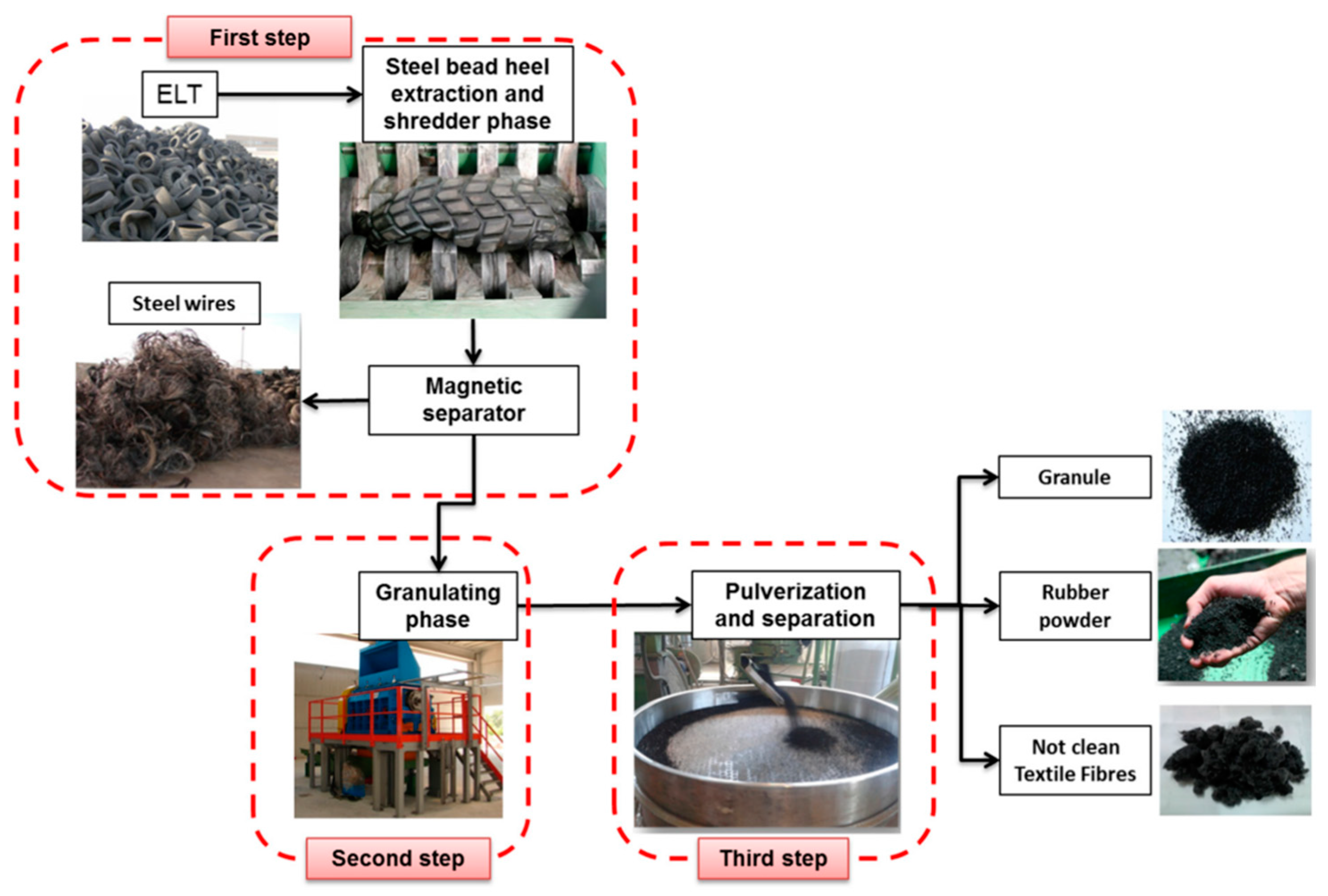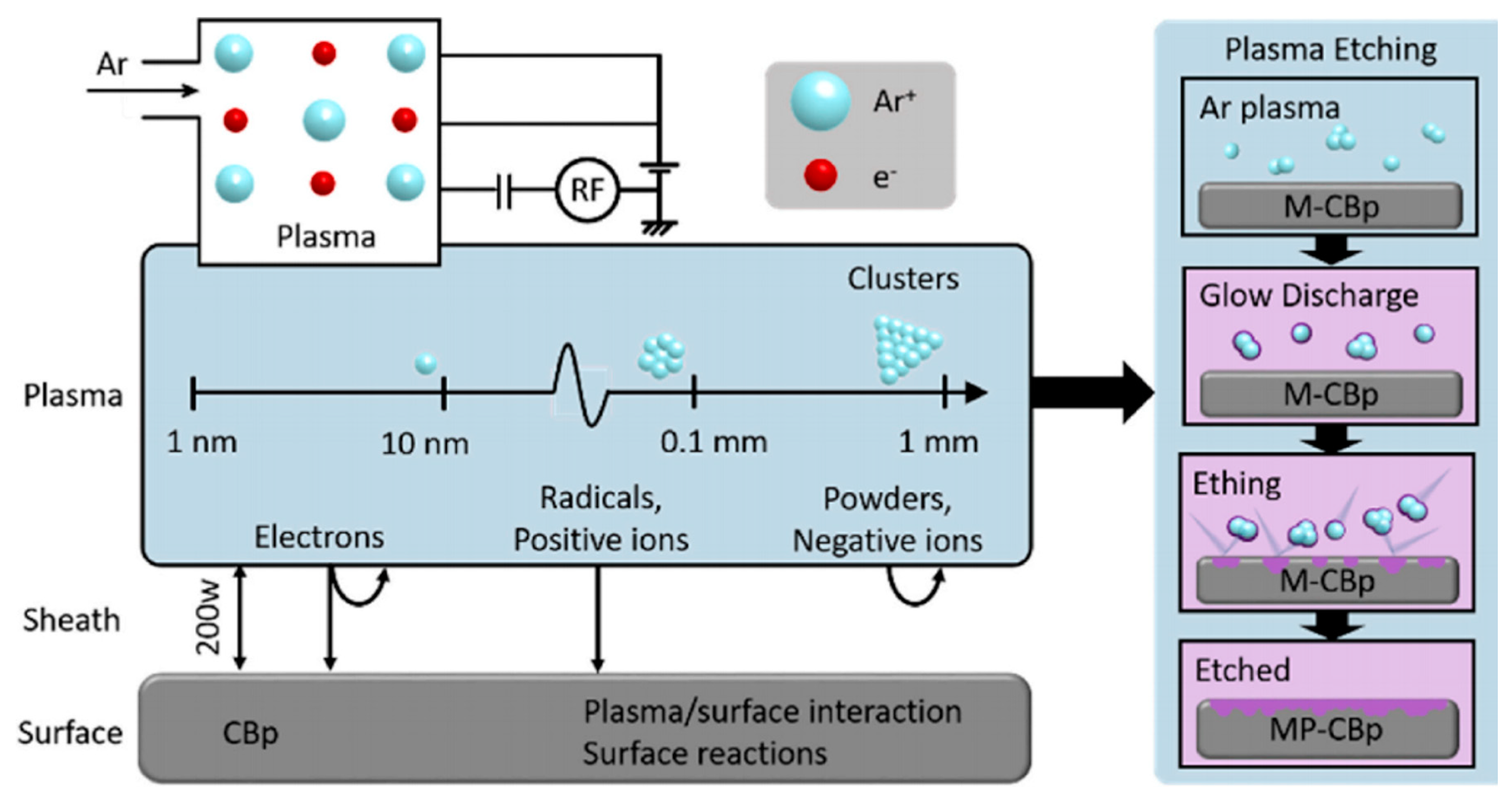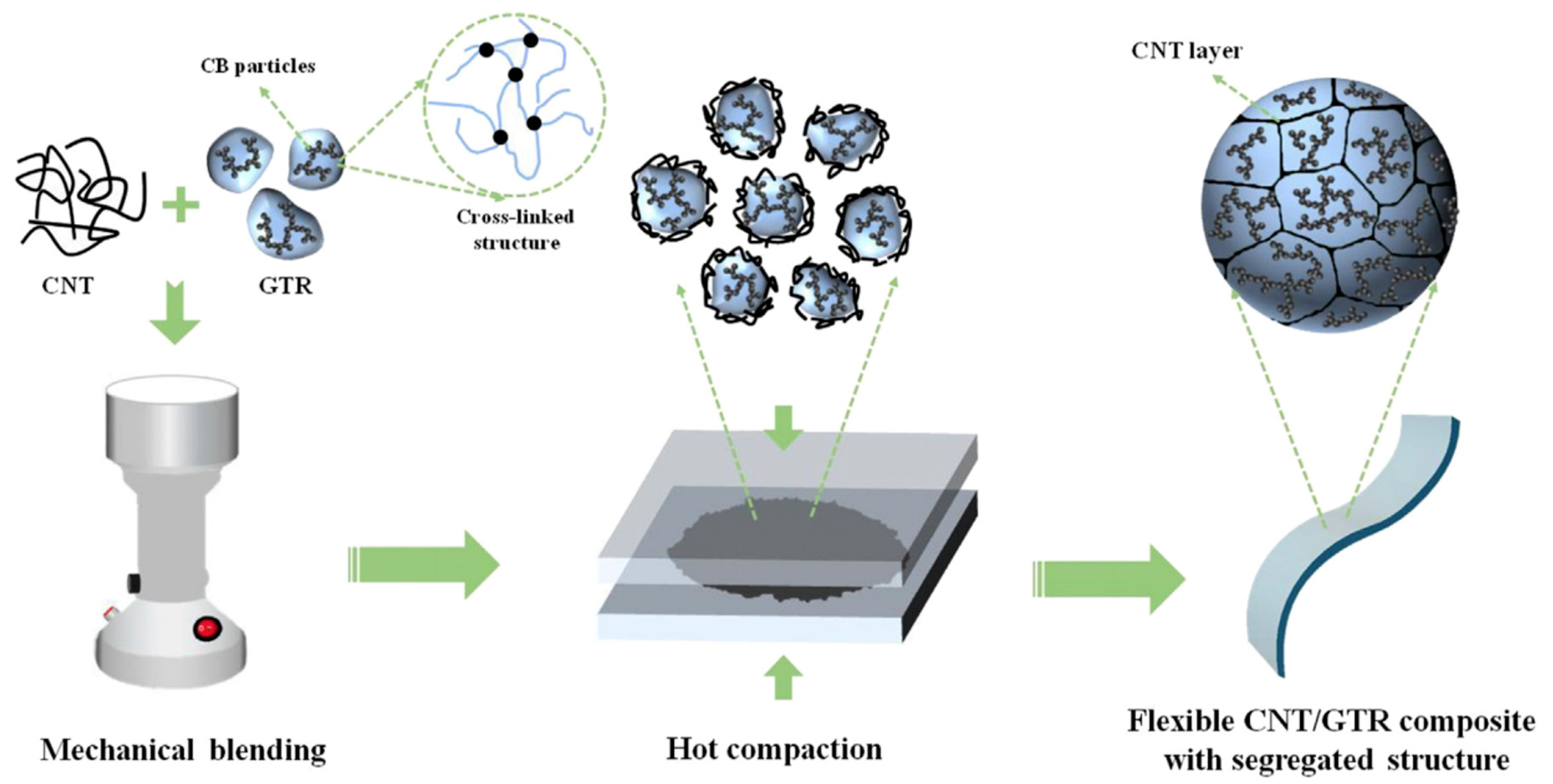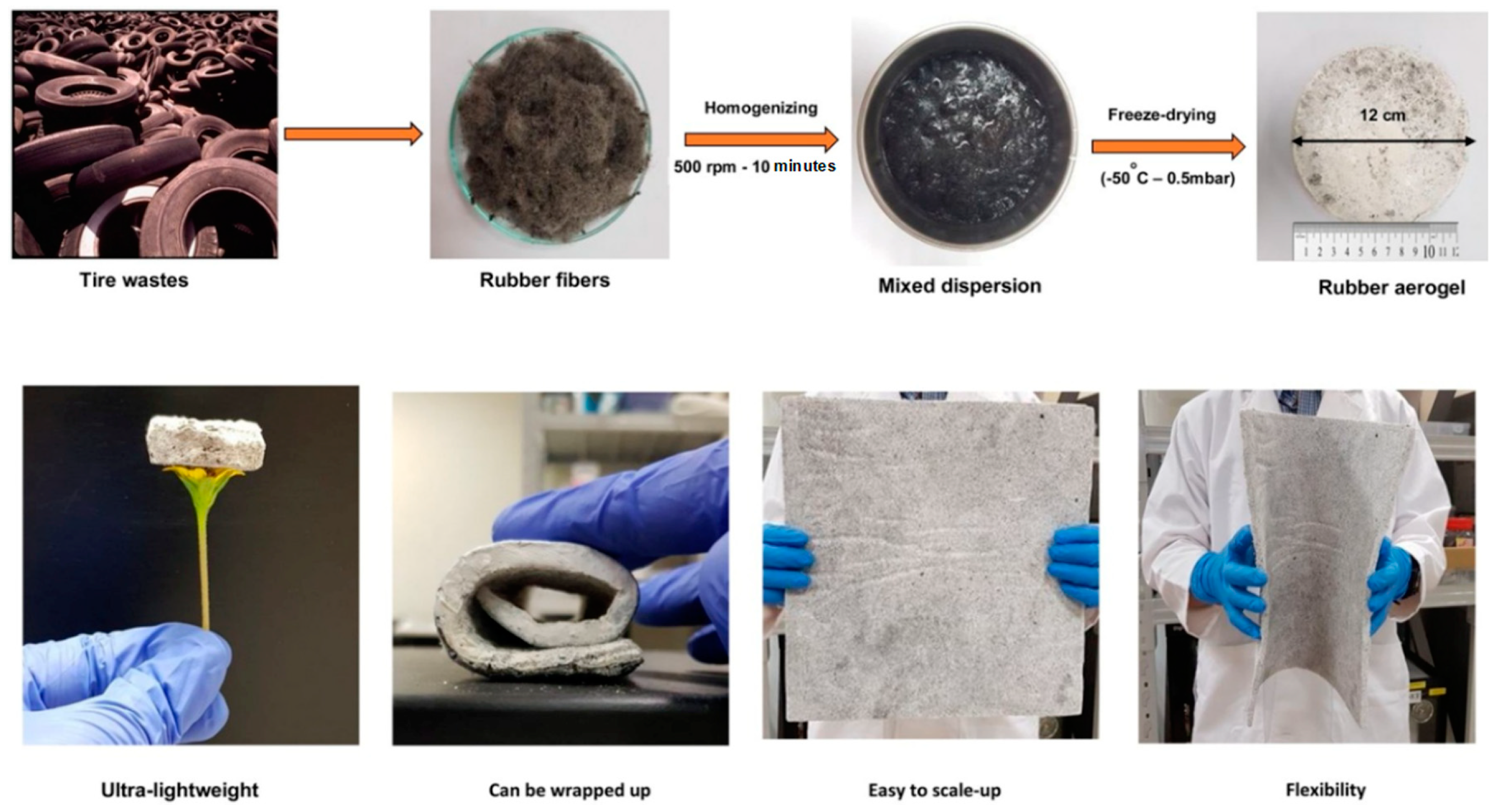Recycling Functional Fillers from Waste Tires for Tailored Polystyrene Composites: Mechanical, Fire Retarding, Electromagnetic Field Shielding, and Acoustic Insulation Properties—A Short Review
Abstract
1. Introduction
2. Overview of the Recycling of Rubber Powders, Carbon Black, and Textile Fibers from Waste Tires
3. Surface Treatments of Waste Tire Rubber Powders, Carbon Black, and Textile Fibers
3.1. Surface Activation of Recycled Waste Rubber Powders
3.2. Surface Modification of Recycled Carbon Black
3.3. Surface Treatments of Recycled Textile Fibers
4. Waste Tire-Derived, Recycled Filler-Tailored PS Composites
4.1. Mechanical Properties
4.2. Fire Retarding Properties
4.3. Conductivity and EMI Shielding Properties
4.4. Acoustic Properties
5. Conclusions and Future Prospects
Author Contributions
Funding
Conflicts of Interest
References
- Tian, X.L.; Zhuang, Q.X.; Han, S.; Li, S.M.; Liu, H.C.; Li, L.; Zhang, J.X.; Wang, C.X.; Bian, H.G. A novel approach of reapplication of carbon black recovered from waste tyre pyrolysis to rubber composites. J. Clean. Prod. 2021, 280, 124460. [Google Scholar] [CrossRef]
- Lei, Y.; Wu, Q.L.; Zhang, Q.G. Morphology and properties of microfibrillar composites based on recycled poly (ethylene terephthalate) and high density polyethylene. Compos. Part A Appl. Sci. Manuf. 2009, 40, 904–912. [Google Scholar] [CrossRef]
- Lei, Y.; Wu, Q.L. Recycling engine oil containers to prepare wood-plastic composites. J. Appl. Polym. Sci. 2011, 122, 964–972. [Google Scholar] [CrossRef]
- Zhang, J.L.; Li, W.G.; Wu, Q.L. Renewable resource-derived elastomer vitrimer and its sustainable manufacturing and application in extreme environmental conditions. BioResources 2023, 18, 4395–4398. [Google Scholar] [CrossRef]
- Samper, M.D.; Garcia-Sanoguera, D.; Parres, F.; López, J. Recycling of expanded polystyrene from packaging. Prog. Rubber Plast. Recycl. Technol. 2010, 26, 83–92. [Google Scholar] [CrossRef]
- Zhang, J.L.; Chen, H.X.; Zhou, Y.; Ke, C.M.; Lu, H.Z. Compatibility of waste rubber powder/polystyrene blends by the addition of styrene grafted styrene butadiene rubber copolymer: Effect on morphology and properties. Polym. Bull. 2013, 70, 2829–2841. [Google Scholar] [CrossRef]
- Lanzón, L.; Cnudde, V.; Kock, T.D.; Dewanckele, J. Microstructural examination and potential application of rendering mortars made of tire rubber and expanded polystyrene wastes. Constr. Build. Mater. 2015, 94, 817–825. [Google Scholar] [CrossRef]
- Lee, S.; Park, Y.K.; Lee, J. Upcycling of plastic and tire waste toward use as modifier for asphalt binder. Energy Environ. 2023, 35, 51–524. [Google Scholar] [CrossRef]
- Merkel, D.R.; Kuang, W.B.; Malhotra, D.; Petrossian, G.; Zhong, L.R.; Simmons, K.L.; Zhang, J.W.; Cosimbescu, L. Waste PET chemical processing to terephthalic amides and their effect on asphalt performance. ACS Sustain. Chem. Eng. 2020, 8, 5615–5625. [Google Scholar] [CrossRef]
- Bhunia, K.; Sablani, S.S.; Tang, J.M.; Rasco, B. Migration of chemical compounds from packaging polymers during microwave, conventional heat treatment, and storage. Compr. Rev. Food Sci. Food Saf. 2013, 12, 523–545. [Google Scholar] [CrossRef]
- Zhang, J.L.; Li, M.C.; Zhang, X.Q.; Ren, S.X.; Dong, L.L.; Lee, S.; Cheng, H.N.; Lei, T.Z.; Wu, Q.L. Surface modified cellulose nanocrystals for tailoring interfacial miscibility and microphase separation of polymer nanocomposites. Cellulose 2019, 26, 4301–4312. [Google Scholar] [CrossRef]
- Zhang, J.L.; Wu, Q.L.; Li, G.Y.; Li, M.C.; Sun, X.X.; Ring, D. Synergistic influence of halogenated flame retardants and nanoclay on flame performance of high density polyethylene and wood flour composites. RSC Adv. 2017, 7, 24895–24902. [Google Scholar] [CrossRef]
- Zhang, J.L.; Wu, Q.L.; Zhang, X.Q.; Gwon, J.; Zhang, R.; Negulescu, I. Mechanical and water resistance performance of physically cross-linked poly(vinyl alcohol) composite with poly(dopamine) modified cellulose nanocrystals. Mater. Today Commun. 2022, 33, 104413. [Google Scholar] [CrossRef]
- Grammelis, P.; Margaritis, N.; Dallas, P.; Rakopoulos, D.; Mavrias, G. A review on management of end of life tires (ELTs) and alternative uses of textile fibers. Energies 2021, 14, 571. [Google Scholar] [CrossRef]
- Fazli, A.; Rodrigue, D. Recycling waste tires into ground tire rubber (GTR)/rubber compounds: A review. J. Compos. Sci. 2020, 4, 103. [Google Scholar] [CrossRef]
- Archibong, F.W.; Sanusi, O.M.; Médéric, P.; Hocine, N.A. An overview on the recycling of waste ground tyre rubbers in thermoplastic matrices: Effect of added fillers. Resour. Conserv. Recycl. 2021, 175, 105894. [Google Scholar] [CrossRef]
- Hejna, A.; Korol, J.; Przybysz-Romatowska, M.; Zedler, L.; Chmielnicki, B.; Formela, K. Waste tire rubber as low-cost and environmentally-friendly modifier in thermoset polymers—A review. Waste Manag. 2020, 108, 106–118. [Google Scholar] [CrossRef] [PubMed]
- Alyousef, R.; Ahmad, W.; Ahmad, A.; Aslam, F.; Joyklad, P.; Alabduljabbar, H. Potential use of recycled plastic and rubber aggregate in cementitious materials for sustainable construction: A review. J. Clean. Prod. 2021, 329, 129736. [Google Scholar] [CrossRef]
- Khoubi-Arani, Z. A comprehensive review on polystyrene/waste rubber blends: Effective parameters on mechanical properties. Polym. Eng. Sci. 2024, 64, 988–1002. [Google Scholar] [CrossRef]
- Dumont, E.R.; Gao, X.; Zheng, J.; Macairan, J.; Hernandez, L.M.; Baesu, B.; Bayen, S.; Robinson, S.A.; Ghoshal, S.; Tufenkji, N. Unraveling the toxicity of tire wear contamination in three freshwater species: From chemical mixture to nanoparticles. J. Hazard. Mater. 2023, 453, 131402. [Google Scholar] [CrossRef]
- Arias, A.H.; Alfonso, M.B.; Girones, L.; Piccolo, M.C.; Marcovecchio, J.E. Synthetic microfibers and tyre wear particles pollution in aquatic systems: Relevance and mitigation strategies. Environ. Pollut. 2022, 295, 118607. [Google Scholar] [CrossRef] [PubMed]
- Arole, K.; Velhal, M.; Tajedini, M.; Xavier, P.G.; Bardasz, E.; Green, M.J.; Liang, L.H. Impacts of particles released from vehicles on environment and health. Tribol. Int. 2023, 184, 108417. [Google Scholar] [CrossRef]
- Landi, D.; Gigli, S.; Germani, M.; Marconi, M. Investigating the feasibility of a reuse scenario for textile fibres recovered from end-of-life tyres. Waste Manag. 2018, 75, 187–204. [Google Scholar] [CrossRef] [PubMed]
- Zhou, J.; Yu, T.M.; Wu, S.J.; Xie, Z.M.; Yang, Y.R. Inverse gas chromatography investigation of rubber reinforcement by modified pyrolytic carbon black from scrap tires. Ind. Eng. Chem. Res. 2010, 49, 1691–1696. [Google Scholar] [CrossRef]
- Zhu, R.; Yadama, V.; Liu, H.; Lin, R.J.T.; Harper, D.P. Fabrication and characterization of Nylon 6/cellulose nanofibrils melt-spun nanocomposite filaments. Compos. Part A Appl. Sci. Manuf. 2017, 97, 111–119. [Google Scholar] [CrossRef]
- Zhu, J.; Zhang, X.X.; Liang, M.; Lu, C.H. Enhancement of processability and foamability of ground tire rubber powder and LDPE blends through solid state shear milling. J. Polym. Res. 2011, 18, 533–539. [Google Scholar] [CrossRef]
- Piszczyk, L.; Hejna, A.; Formela, K.; Danowska, M.; Strankowski, M. Effect of ground tire rubber on structural, mechanical and thermal properties of flexible polyurethane foams. Iran. Polym. J. 2015, 24, 75–84. [Google Scholar] [CrossRef]
- Sonnier, R.; Leroy, E.; Clerc, L.; Bergeret, A.; Lopez-Cuesta, J.M. Polyethylene/ground tyre rubber blends: Influence of particle morphology and oxidation on mechanical properties. Polym. Test. 2007, 26, 274–281. [Google Scholar] [CrossRef]
- Sadaka, F.; Campistron, I.; Laguerre, A.; Pilard, J.F. Controlled chemical degradation of natural rubber using periodic acid: Application for recycling waste tyre rubber. Polym. Degrad. Stab. 2012, 97, 816–828. [Google Scholar] [CrossRef]
- Colom, X.; Carrillo, F.; Cañavate, J. Composites reinforced with reused tyres: Surface oxidant treatment to improve the interfacial compatibility. Compos. Part A Appl. Sci. Manuf. 2007, 38, 44–50. [Google Scholar] [CrossRef]
- Colom, X.; Cañavate, J.; Carrillo, F.; Suñol, J.J. Effect of the particle size and acid pretreatments on compatibility and properties of recycled HDPE plastic bottles filled with ground tyre powder. J. Appl. Polym. Sci. 2009, 112, 1882–1890. [Google Scholar] [CrossRef]
- Rajalingam, P.; Baker, W.E. The role of functional polymers in ground rubber tire-polyethylene composite. Rubber Chem. Technol. 1992, 65, 908–916. [Google Scholar] [CrossRef]
- Rajalingam, P.; Sharpe, J.; Baker, W.E. Ground rubber tire/thermoplastic composites: Effect of different ground rubber tires. Rubber Chem. Technol. 1993, 66, 664–677. [Google Scholar] [CrossRef]
- Oliphant, K.; Baker, W.E. The use of cryogenically ground rubber tires as a filler in polyolefin blends. Polym. Eng. Sci. 1993, 33, 166–174. [Google Scholar] [CrossRef]
- Kakroodi, A.R.; Rodrigue, D. Impact modification of polypropylene-based composites using surface-coated waste rubber crumbs. Polym. Compos. 2014, 35, 2280–2289. [Google Scholar] [CrossRef]
- Lee, S.H.; Shanmugharaj, A.M.; Sridhar, V.; Zhang, Z.X.; Kim, J.K. Preparation and characterization of polypropylene and waste tire powder modified by allylamine blends. Polym. Advan. Technol. 2009, 20, 620–625. [Google Scholar] [CrossRef]
- Martinez, J.D.; Cardona-Uribe, N.; Murillo, R.; Garcia, T.; Lopez, J.M. Carbon black recovery from waste tire pyrolysis by demineralization: Production and application in rubber compounding. Waste Manag. 2019, 85, 574–584. [Google Scholar] [CrossRef] [PubMed]
- Zhang, X.; Li, H.; Cao, Q.; Jin, L.; Wang, F. Upgrading pyrolytic residue from waste tires to commercial carbon black. Waste Manag. Res. 2018, 36, 436–444. [Google Scholar] [CrossRef] [PubMed]
- Chaala, A.; Darmstadt, H.; Roy, C. Acid-base method for the demineralization of pyrolytic carbon black. Fuel Process. Technol. 1996, 46, 1–15. [Google Scholar] [CrossRef]
- Ma, Y.J.; Zhao, H.Y.; Zhang, X.J.; Fan, C.Y.; Zhuang, T.; Sun, C.; Zhao, S.G. Structure optimization of pyrolysis carbon black from waste tire and its application in natural rubber composites. Appl. Surf. Sci. 2022, 593, 153389. [Google Scholar] [CrossRef]
- Zhao, S.Q.; Tang, D.N.; Fang, Y.C.; Hao, X.L.; Liu, Y.N.; Liu, J.W.; Zhao, H.Y.; Sun, C.; Hua, C.; Schlarb, A.K.; et al. Enhanced wear resistance of sustainable tire materials with plasma modified pyrolysis carbon black. Carbon 2023, 213, 118201. [Google Scholar] [CrossRef]
- Valentini, F.; Dorigato, A.; Pegoretti, A. Evaluation of the role of devulcanized rubber on the thermo-mechanical properties of polystyrene. J. Polym. Environ. 2020, 28, 1737–1748. [Google Scholar] [CrossRef]
- Luo, S.J.; Ooij, W.J.V. Surface modification of textile fibers for improvement of adhesion to polymeric matrices: A review. J. Adhes. Sci. Technol. 2002, 16, 1715–1735. [Google Scholar] [CrossRef]
- Lourenco, E.; Felisberti, M.I. Thermal and mechanical properties of in situ polymerized PS/EPDM blends. Eur. Polym. J. 2006, 42, 2632–2645. [Google Scholar] [CrossRef]
- Al-Malaika, S.; Artus, K. Chemical modification of polymer blends by reactive processing: In situ reactions of interlinking agents in PS/EPDM blends. J. Appl. Polym. Sci. 1998, 69, 1933–1951. [Google Scholar] [CrossRef]
- Crevecoeur, J.J.; Nelissen, L.; van der Sanden, M.C.M.; Lemstra, P.J.; Mencer, H.J. Impact strength of reactively extruded polystyrene/ethylene-propylene-diene rubber blends. Polymer 1995, 36, 753–757. [Google Scholar] [CrossRef]
- Chuayjuljit, S.; Moolsin, S.; Potiyaraj, P. Use of natural rubber-g-polystyrene as a compatibilizer in casting natural rubber/polystyrene blend films. J. Appl. Polym. Sci. 2005, 95, 826–831. [Google Scholar] [CrossRef]
- Scuracchio, C.H.; Bretas, R.E.S.; Isayev, A.I. Blends of PS with SBR devulcanized by ultrasound: Rheology and morphology. J. Elastom. Plast. 2004, 36, 45–75. [Google Scholar] [CrossRef]
- Haanh, T.; Vu-Khanh, T. Fracture and yielding behaviors of polystyrene/ethylene-propylene rubber blends: Effects of interfacial agents. Polym. Eng. Sci. 2001, 41, 2073–2081. [Google Scholar] [CrossRef]
- Wang, Z.B.; Zhang, Y.X.; Du, F.L.; Wang, X. Thermoplastic elastomer based on high impact polystyrene/ethylene-vinyl acetate copolymer/waste ground rubber tire powder composites compatibilized by styrene-butadiene-styrene block copolymer. Mater. Chem. Phys. 2012, 136, 1124–1129. [Google Scholar] [CrossRef]
- Zhang, J.L.; Chen, H.X.; Ke, C.M.; Zhou, Y.; Lu, H.Z.; Wang, D.L. Graft polymerization of styrene onto waste rubber powder and surface characterization of graft copolymer. Polym. Bull. 2012, 68, 789–801. [Google Scholar] [CrossRef]
- Andrade Junior, A.J.; Saron, C. Mechanical recycling of expanded polystyrene and tire rubber waste as compatibilized and toughened blends. J. Appl. Polym. Sci. 2023, 140, 54267. [Google Scholar] [CrossRef]
- Barreto Luna, C.B.; Siqueira, D.D.; Araújo, E.M.; de Souza Morais, D.D.; Bezerra, E.B. Toughening of polystyrene using styrene-butadiene rubber (SBRr) waste from the shoe industry. REM Int. Eng. J. 2018, 71, 253–260. [Google Scholar] [CrossRef]
- Montagna, L.S.; Santana, R.M.C. Influence of rubber particle size on properties of recycled thermoplastics containing rubber tyre waste. Plast. Rubber Compos. 2012, 41, 256–262. [Google Scholar] [CrossRef]
- Mujal-Rosas, R.; Ramis-Juan, X. Electrical application of polystyrene (PS) reinforced with old tire rubber (GTR): Dielectric, thermal, and mechanical properties. Sci. Eng. Compos. Mater. 2013, 20, 233–244. [Google Scholar] [CrossRef]
- Zhao, J.; Wei, D.Y.; Wang, Z.B. Thermoplastic elastomers based on high-impact polystyrene/waste styrene butadiene rubber powder blends enhanced by styrene-butadiene-styrene block copolymer and aromatic oil. J. Macromol. Sci. Phys. 2015, 54, 262–274. [Google Scholar] [CrossRef]
- Nguyen, H.T.; Crittenden, K.; Weiss, L.; Bardaweel, H. Recycle of waste tire rubber in a 3D printed composite with enhanced damping properties. J. Clean. Prod. 2022, 368, 133085. [Google Scholar] [CrossRef]
- Morgan, A.B.; Gilman, J.W. An overview of flame retardancy of polymeric materials: Application, technology, and future directions. Fire Mater. 2013, 37, 259–279. [Google Scholar] [CrossRef]
- Jakab, E.; Uddin, M.A.; Bhaskar, T.; Sakata, Y. Thermal decomposition of flame-retarded high-impact polystyrene. J. Anal. Appl. Pyrolysis 2003, 68–69, 83–99. [Google Scholar] [CrossRef]
- Mahdavian, A.R.; Morshedian, J.; Rezaie, M. The comparison between synergistic effect of Sb2O3 and Al(OH)3 on the flame-retardancy of HIPS in the presence of tetrabromobisphenol-A. Iran. Polym. J. 2004, 13, 219–224. [Google Scholar]
- Liu, J.C.; Yu, Z.L.; Chang, H.B.; Zhang, Y.B.; Shi, Y.Z.; Luo, J.; Pan, B.L.; Lu, C. Thermal degradation behavior and fire performance of halogen-free flame-retardant high impact polystyrene containing magnesium hydroxide and microencapsulated red phosphorus. Polym. Degrad. Stab. 2014, 103, 83–95. [Google Scholar] [CrossRef]
- Wiśniewska, P.; Wójcik, N.; Ryl, J.; Bogdanowicz, R.; Vahabi, H.; Formela, K.; Saeb, M.R. Rubber wastes recycling for developing advanced polymer composites: A warm handshake with sustainability. J. Clean. Prod. 2023, 427, 139010. [Google Scholar] [CrossRef]
- Zhang, L.; Li, Z.; Wang, D.Y. Polydopamine-assisted strategies for preparation of fire-safe polymeric materials: A review. Eur. Polym. J. 2020, 138, 109973. [Google Scholar] [CrossRef]
- Sykam, K.; Försth, M.; Sas, G.; Restás, Á.; Das, O. Phytic acid: A bio-based flame retardant for cotton and wool fabrics. Ind. Crops Prod. 2021, 164, 113349. [Google Scholar] [CrossRef]
- Okoye, C.O.; Jones, I.; Zhu, M.M.; Zhang, Z.Z.; Zhang, D.K. Manufacturing of carbon black from spent tyre pyrolysis oil-A literature review. J. Clean. Prod. 2021, 279, 123336. [Google Scholar] [CrossRef]
- Zhang, Q.Y.; Wang, J.X.; Zhang, B.Y.; Guo, B.H.; Yu, J.; Guo, Z.X. Improved electrical conductivity of polymer/carbon black composites by simultaneous dispersion and interaction-induced network assembly. Compos. Sci. Technol. 2019, 179, 106–114. [Google Scholar] [CrossRef]
- Kuester, S.; Merlini, C.; Barra, G.M.O.; Ferreira, J.C., Jr.; Lucas, A.; de Souza, A.C.; Soares, B.G. Processing and characterization of conductive composites based on poly(styrene-b-ethylene-ran-butylene-b-styrene) (SEBS) and carbon additives: A comparative study of expanded graphite and carbon black. Compos. Part B Eng. 2016, 84, 236–247. [Google Scholar] [CrossRef]
- Jia, L.C.; Li, Y.K.; Yan, D.X. Flexible and efficient electromagnetic interference shielding materials from ground tire rubber. Carbon 2017, 121, 267–273. [Google Scholar] [CrossRef]
- Ruzickij, R.; Astrauskas, T.; Vaktere, S.; Grubliauskas, R. Sound absorption properties evaluation and analysis of recycled tyre textile fibre waste. Environ. Clim. Technol. 2020, 24, 318–328. [Google Scholar] [CrossRef]
- José Jimenez-Espada, F.; Villanueva, J.A.B.; Trujillo, E.C.; Blanco, A.M. Optimal design of acoustic material from tire fluff. Mater. Des. 2011, 32, 3608–3616. [Google Scholar] [CrossRef]
- Lee, Y.; Joo, C. Sound absorption properties of recycled polyester fibrous assembly absorbers. Autex Res. J. 2003, 3, 78–84. [Google Scholar] [CrossRef]
- Zhu, X.D.; Kim, B.J.; Wang, Q.W.; Wu, Q.L. Recent advances in the sound insulation properties of bio-based materials. BioResources 2014, 9, 1764–1786. [Google Scholar] [CrossRef]
- Liu, W.C.; Liu, S.Y.; Liu, T.; Liu, T.; Zhang, J.W.; Liu, H. Eco-friendly post-consumer cotton waste recycling for regenerated cellulose fibers. Carbohydr. Polym. 2019, 206, 141–148. [Google Scholar] [CrossRef] [PubMed]
- Maderuelo-Sanz, R.; Nadal-Gisbert, A.V.; Crespo-Amorós, J.E.; Parres-García, F. A novel sound absorber with recycled fibers coming from end of life tires (ELTs). Appl. Acoust. 2012, 73, 402–408. [Google Scholar] [CrossRef]
- Ružickij, R.; Grubliauskas, R. Sound absorption: Dependence of rubber particles impurities in tyre textile fibre. Environ. Clim. Technol. 2022, 26, 331–340. [Google Scholar] [CrossRef]
- Tiuc, A.E.; Vermeşan, H.; Gabor, T.; Vasile, O. Improved sound absorption properties of polyurethane foam mixed with textile waste. Energy Procedia 2016, 85, 559–565. [Google Scholar] [CrossRef]
- Thai, Q.B.; Chong, R.O.; Nguyen, P.T.T.; Le, D.K.; Le, P.K.; Phan-Thien, N.; Duong, H.M. Recycling of waste tire fibers into advanced aerogels for thermal insulation and sound absorption applications. J. Environ. Chem. Eng. 2020, 8, 104279. [Google Scholar] [CrossRef]
- Zhang, J.L.; De Hoop, C.F.; Wu, Q.L. Environmentally friendly, low thermal conductivity, fire retarding, Mechanically robust cellulose nanofibril aerogels and their use for early fire alarm sensors in thermally insulating sustainable building applications. BioResources 2024, 19, 15–18. [Google Scholar] [CrossRef]
- Naskar, A.K.; Bi, Z.H.; Li, Y.C.; Akato, S.K.; Saha, D.; Chi, M.F.; Bridgesc, C.A.; Paranthaman, M.P. Tailored recovery of carbons from waste tires for enhanced performance as anodes in lithium-ion batteries. RSC Adv. 2014, 4, 38213–38221. [Google Scholar] [CrossRef]
- Zhang, C.; Wu, B.H.; Du, Y.; Ma, M.Q.; Xu, Z.K. Mussel-inspired polydopamine coatings for large-scale and angle-independent structural colors. J. Mater. Chem. C 2017, 5, 3898–3902. [Google Scholar] [CrossRef]
- Kohri, M. Progress in polydopamine-based melanin mimetic materials for structural color generation. Sci. Technol. Adv. Mater. 2020, 21, 833–848. [Google Scholar] [CrossRef] [PubMed]
- Hu, Y.P.; Gao, Z.J. Sensitive detection of Sudan dyes using tire-derived carbon dots as a fluorescent sensor. Spectrochim. Acta A Mol. Biomol. Spectrosc. 2020, 239, 118514. [Google Scholar] [CrossRef] [PubMed]
- Mohammad, N.N.; Omer, K.M.; Baban, S. Valorization of tire wastes to carbon quantum dots (P-CDs) and photocatalytic degradation enhancement of organic wastes using ZnO-CDs nanocomposites. J. Mater. Sci. Mater. Electron. 2019, 30, 11598–11606. [Google Scholar] [CrossRef]
- Veldevi, T.; Raghu, S.; Kalaivani, R.A.; Shanmugharaj, A.M. Waste tire derived carbon as potential anode for lithium-ion batteries. Chemosphere 2022, 288, 132438. [Google Scholar] [CrossRef] [PubMed]
- Li, Y.C.; Adams, R.A.; Arora, A.; Pol, V.G.; Levine, A.M.; Lee, R.J.; Akato, K.; Naskar, A.K.; Paranthaman, M.P. Sustainable potassium-ion battery anodes derived from waste-tire rubber. J. Electrochem. Soc. 2017, 164, 1234. [Google Scholar] [CrossRef]
- Jiang, K.; Gao, X.L.; Feng, X.Y.; Wang, Y.H.; Li, Z.G.; Lin, H.W. Carbon dots with dual-emissive, robust, and aggregation-induced room-temperature phosphorescence characteristics. Angew. Chem. Int. Ed. 2020, 59, 1263–1269. [Google Scholar] [CrossRef]
- Wang, X.H.; Han, Y.Y.; Li, W.H.; Li, J.Z.; Ren, S.H.; Wang, M.R.; Han, G.T.; Yu, J.Y.; Zhang, Y.M.; Zhao, H.G. Doped carbon dots enable highly efficient multiple-color room temperature phosphorescence. Adv. Opt. Mater. 2024, 12, 2301962. [Google Scholar] [CrossRef]
- Sun, X.X.; Wu, Q.L.; Zhang, J.L.; Qing, Y.; Wu, Y.Q.; Lee, S. Rheology, curing temperature and mechanical performance of oil well cement: Combined effect of cellulose nanofibers and graphene nano-platelets. Mater. Des. 2017, 114, 92–101. [Google Scholar] [CrossRef]
- Lin, M.Y.; Grandgeorge, P.; Jimenez, A.M.; Nguyen, B.H.; Roumeli, E. Long-term hindrance effects of algal biomatter on the hydration reactions of ordinary portland cement. ACS Sustain. Chem. Eng. 2023, 11, 8242–8254. [Google Scholar] [CrossRef]
- Sun, X.X.; Wu, Q.L.; Lee, S.; Qing, Y.; Wu, Y.Q. Cellulose nanofibers as a modifier for rheology, curing and mechanical performance of oil well cement. Sci. Rep. 2016, 6, 31654. [Google Scholar] [CrossRef]
- Koo, M.S.; Wu, Q.L.; Lee, S.; Hubbe, M.A. Rheological properties of lignocellulosic nanomaterial aqueous suspensions as influenced by water-soluble biopolymer additives. ACS Sustain. Chem. Eng. 2021, 9, 17049–17060. [Google Scholar] [CrossRef]
- Wu, Y.J.; Zhang, Y.; Wang, X.Y.; Hu, W.T.; Zhao, S.; Officer, T.; Luo, K.; Tong, K.; Du, C.C.; Zhang, L.Q.; et al. Twisted-layer boron nitride ceramic with high deformability and strength. Nature 2024, 626, 779–784. [Google Scholar] [CrossRef] [PubMed]
- Liu, T.; Huang, A.; Geng, L.H.; Lian, X.H.; Chen, B.Y.; Hsiao, B.S.; Kuang, T.R.; Peng, X.F. Ultra-strong, tough and high wear resistance high-density polyethylene for structural engineering application: A facile strategy towards using the combination of extensional dynamic oscillatory shear flow and ultra-high-molecular-weight polyethylene. Compos. Sci. Technol. 2018, 167, 301–312. [Google Scholar] [CrossRef]
- Yue, Y.H.; Gao, Y.F.; Hu, W.T.; Xu, B.; Wang, J.; Zhang, X.J.; Zhang, Q.; Wang, Y.B.; Ge, B.H.; Yang, Z.Y.; et al. Hierarchically structured diamond composite with exceptional toughness. Nature 2020, 582, 370–374. [Google Scholar] [CrossRef]
- Dobrotă, D.; Dobrotă, G.; Dobrescu, T. Improvement of waste tyre recycling technology based on a new tyre markings. J. Clean. Prod. 2020, 260, 121141. [Google Scholar] [CrossRef]




| Composition | Passenger Cars | Trucks |
|---|---|---|
| Rubber | 47% | 45% |
| Carbon Black | 21.5% | 22% |
| Fiber | 5.5% | - |
| Steel | 16.5% | 25% |
| Zinc Oxide | 1% | 2% |
| Additives | 7.5% | 5% |
| Rubber Content of PS Composites | Impact Strength | Tensile Strength | Bending Strength | Hardness | Elongation at Break |
|---|---|---|---|---|---|
| EPS-Tire Rubber [52] 10 wt% a 30 wt% a | + 35% b 55% b | + 40% b 8% b | NA NA NA | NA NA NA | + 27% b 50% b |
| PS-Waste SBR [53] 20 wt% a 50 wt% a | + 38% b 65% b | − 26% b 59% b | NA NA NA | − 5% b 12% b | NA NA NA |
| HIPS-Tire Rubber [54] 10 wt% a 30 wt% a | − 66% b 76% b | − 44% b 50% b | − 59% b 46% b | NA NA NA | − 90% b 86% b |
| PS-Tire Rubber [55] 5 wt% a 10 wt% a | − 61% b 69% b | − 18% b 26% b | NA NA NA | NA NA NA | − 34% b 43% b |
| PS-Tire Rubber [42] 20 wt% a 60 wt% a | + 76% b 75% b | − 36% b 72% b | NA NA NA | NA NA NA | + 13% b 23% b |
| HIPS-Waste SBR [56] 40 wt% a 80 wt% a | NA NA NA | − 46% b 63% b | NA NA NA | Constant Constant Constant | + 72% b 92% b |
| ABS-Waste Tire [57] 20 wt% a 50 wt% a PS-Tire Rubber [6] 10 wt% a 30 wt% a | NA NA NA + 33% b 20% b | − 40% b 78% b − 36% b 58% b | NA NA NA NA NA NA | NA NA NA NA NA NA | − 23% b 26% b NA NA NA |
Disclaimer/Publisher’s Note: The statements, opinions and data contained in all publications are solely those of the individual author(s) and contributor(s) and not of MDPI and/or the editor(s). MDPI and/or the editor(s) disclaim responsibility for any injury to people or property resulting from any ideas, methods, instructions or products referred to in the content. |
© 2024 by the authors. Licensee MDPI, Basel, Switzerland. This article is an open access article distributed under the terms and conditions of the Creative Commons Attribution (CC BY) license (https://creativecommons.org/licenses/by/4.0/).
Share and Cite
Zhang, J.; Liu, H.; Sablani, S.S.; Wu, Q. Recycling Functional Fillers from Waste Tires for Tailored Polystyrene Composites: Mechanical, Fire Retarding, Electromagnetic Field Shielding, and Acoustic Insulation Properties—A Short Review. Materials 2024, 17, 2675. https://doi.org/10.3390/ma17112675
Zhang J, Liu H, Sablani SS, Wu Q. Recycling Functional Fillers from Waste Tires for Tailored Polystyrene Composites: Mechanical, Fire Retarding, Electromagnetic Field Shielding, and Acoustic Insulation Properties—A Short Review. Materials. 2024; 17(11):2675. https://doi.org/10.3390/ma17112675
Chicago/Turabian StyleZhang, Jinlong, Hang Liu, Shyam S. Sablani, and Qinglin Wu. 2024. "Recycling Functional Fillers from Waste Tires for Tailored Polystyrene Composites: Mechanical, Fire Retarding, Electromagnetic Field Shielding, and Acoustic Insulation Properties—A Short Review" Materials 17, no. 11: 2675. https://doi.org/10.3390/ma17112675
APA StyleZhang, J., Liu, H., Sablani, S. S., & Wu, Q. (2024). Recycling Functional Fillers from Waste Tires for Tailored Polystyrene Composites: Mechanical, Fire Retarding, Electromagnetic Field Shielding, and Acoustic Insulation Properties—A Short Review. Materials, 17(11), 2675. https://doi.org/10.3390/ma17112675







